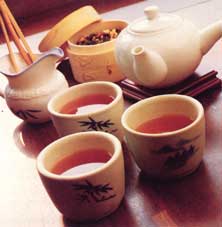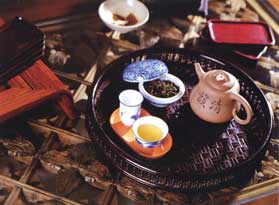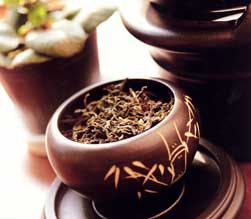| Tea -- A Chinese way of life and culture | |
| http://www.sina.com.cn 2004/05/31 15:55 中国周刊 | |
As spring comes, everything in the suburbs near Hangzhou, capital of east China's Zhejiang province, has turned green. The blossoms appear in late March or early April, two brief pink-flowered weeks that give the mountain its name, Peach Blossom Mountain. Zhou Dayong, a tea merchant from Beijing, has no leisure time to enjoy the picturesque and tranquil lagoon on the city's western edge, as he is on the go almost non-stop to purchase fresh green tea as soon as possible. Since the outbreak of SARS in the spring of 2003, Beijing residents have shown more interest in green tea, which is popularly regarded as an organic and healthy drink. "In years past, the locals preferred cheap varieties, such as jasmine tea, but now that has changed, and more people know about better varieties of tea," Zhou said. Zhou opened a tea shop on a street known for tea wholesaling near Beijing West Railway Station three years ago. At the beginning, only few people bought high-priced green tea. Last year, however, more than 40 percent of his customers selected green tea and 25 per cent black tea varieties, including those of high quality, while the rest still preferred jasmine tea and other low-priced teas. It is expected that more than half the customers will buy green tea, especially the best one produced a few days before Qingming (meaning 'Pure Brightness' - the 5th solar cycle), when the new twigs have just begun to sprout, carrying 'one leaf and a bud,' as the saying goes. The tea-harvesting season depends on the local climate and varies from area to area in China. On the shores of West Lake in Hangzhou, where the famous Longjing (Dragon Well) green tea comes from, picking begins at the end of March and lasts until October, altogether 20 to 30 pickings from the same trees, at intervals varying from seven to ten days. With longer intervals, the quality of the tea would deteriorate. A skilled woman picker is able to gather a mere 600 grams (a little over a pound) of green tea leaves in a day. .1 To produce one kilogram (2.2 lbs.) of finished tea, 60,000 tender leaves have to be plucked. In days of old, Dragon Well tea of this grade was meant solely for the imperial household and therefore known as "tribute tea". Dragon Well tea 2leaves produce a pure and clear beverage with a light, refreshing fragrance. Green tea is prepared with hot, but not boiling water - it will turn bitter if brewed too hot. Tea experts also say that the second infusion brewed from green tea leaves produces the best flavour. Generally, high quality tea leaves are mostly produced in the provinces of East and South China, such as Zhejiang, Jiangsu, Anhui, Jiangxi, Yunnan and Hunan. Tea, along with porcelain and silk, has long been one of China's most significant exports. Tea binds us to our ancient traditions, to health, to close relationships and friendship.
The legend of tea In Chinese history, many stories were told about the origins of tea, generation after generation. It is said that a Chinese emperor was whiling away his time away under a tree in the courtyard. He felt the warmth of the sun in the spring afternoon soak into his bones when some leaves fell into the pot of water he was boiling. He drank the green water and found, to his surprise, that it made him feel uplifted and revitalised. He rightly concluded that the leaves had caused this to happen and therefore took some back for further experimentation. This small incident triggered the beginning of tea drinking in China and in the world. Another story tells us that tea was discovered by a poor woodcutter who was chopping trees in the forest when he saw several monkeys plucking leaves off a tree and chewing them. He tasted some of the leaves, a little bitter but giving off a faint scent. He liked what he tasted and took some leaves back to his village, where he told others of his discovery. Soon, everyone was adding leaves from the tree to their drinks. According to Lu Yu, the writer of 'Tea Classics'3 (Cha Jing) during the Tang dynasty (618-907), Chinese tea had already enjoyed a history of more than 4,000 years. Lu Yu entered the Buddhist monkhood early in life but returned to secular life in his old age. He was later best known for summarising the knowledge and experience of his predecessors and contemporaries into the first compendium in the world on tea - the now famous Tea Classics4. This work helped to popularise the art of tea drinking all across China, making avid tea drinkers out of everyone from emperor and minister to street hawker and soldier. Even neighbouring countries - Korea, Japan and Southeast Asia came to adopt the tea drinking custom. Tea was used as offerings in the Western Zhou (1100 BC-771 BC), as a vegetable in the Spring and Autumn period (770 BC-476 BC), and as medicine in the Warring States period 475 BC-221 BC). Later, during the Western Han dynasty (206 BC-25 AD), it became a major commodity. During the 300 years between the Three Kingdoms period (220-280) and the North and South dynasties (386-589), especially the latter, Buddhism became popular, and Buddhists applied tea as an aid in Zen meditation, and tea trees were planted along valleys around temples. That is why people say tea and Buddhism accompanied each other in their development. During the Tang dynasty tea became a popular soft drink for ordinary people. In the Ming dynasty (1368-1644), the tea trade began to play an important role in economic development. The "Tea and Horse Bureau" was set up to supervise the tea trade. Since ancient times, Chinese people, including intellectuals and officials, have developed the hobby of visiting teahouses, where they could chat and deal with affairs.
Teahouses Just like coffee in Western countries, tea also played a major role in social life. Tea appreciation was a major hallmark of a well-to-do lifestyle and sometimes even was deemed to define the characteristics of a highly cultured person. Scholars and gentry alike would not have been able to entertain their guests without tea or the teahouse. Many teahouses in Chinese cities, including Chengdu, Hangzhou and Yangzhou, have a well-deserved reputation, not only because of their number, but also because of their unique ways of serving and drinking tea. In the same way as cafés in Western countries, teahouses are not frequented by people who are actually thirsty5. Retired people, for example, spend a little money at a teahouse and sit there all day long to chat. Sometimes, people bring guests. They may eat melon or sunflower seeds or some local snacks while they chat or play chess and cards. Some of the teahouses also have theatrical performances, such as storytelling, crosstalk (a kind of comic dialogue) and local operas. There are certain rituals associated with tea drinking. It is polite to refill others' cups before one's own - and to acknowledge this courtesy by tapping two fingers on the table. In teahouses or restaurants (in southern parts of China, at least), removing the lid from the pot, or turning it over, serves to request a refill. Teahouses are also places for people from various businesses and organisations to get together to hold trade talks or make deals. In the past three years, more urban people have begun to go to teahouses for business talks or rest. Even though coffee culture has captured the imagination of young people in particular, teahouses have been appearing in the downtown areas of many cities, much like mushrooms on the mountain slopes after a drizzle or rain. Why is the teahouse business still booming after thousands of years of history? One important reason is that since ancient times teahouses have played the role as of important venue for ordinary people to exchange information and make friends. Today, although almost every family has radio, colour TV sets, a personal computer and there are a lot of coffee bars, such as Starbucks, in every big city, many people, especially businessmen and elderly people, still like to go to teahouses, because they believe that a teahouse is a good place to meet old friends and to communicate with each other, in addition to being a quiet or secluded spot for the attainment of soundness of mind.
Tea and health The custom of drinking tea is deeply ingrained in almost all Chinese, including ethnic groups, and has been for over a thousand years. From ancient times to today, tea has been a necessity of the ordinary life of anyone Chinese. In the areas of the Bouyei ethnic group, there is a kind of tea that possesses a special taste and a beautiful name. It is called Girl Tea. Before Qingming, girls collect tender tea leaves from the mountains, parch them to a certain degree of humidity, roll them piece by piece into cones, dry them in the sun and process them into Girl Tea. This kind of tea is not only beautiful in shape, but also of high quality. It is the prime tea and only presented to one's best friends. When dating or making an engagement, girls will present this tea to their lovers. Girl Tea is collected by girls and made by girls, hence the name. An old Chinese saying identifies the seven basic daily necessities as fuel, rice, oil, salt, soy sauce, vinegar, and tea. Tea is always offered immediately to a guest in Chinese home. Serving a cup of tea is more than a matter of mere politeness; it is a symbol of togetherness, a sharing of something enjoyable and a way of showing respect to visitors. To not take at least a sip might be considered rude in some areas. In earlier times, if the host held his teacup and said "please have tea", the guest would take the cue as a suggestion to leave. In summer or in warm climates, tea seems to dispel the heat and bring on instant coolness together with a feeling of relaxation. For this reason, teahouses abound in towns and market villages in South China and provide elderly retirees with the locales to meet and chat over a cup of tea. Medically, the tea leaf contains a number of chemicals, of which 20-30 per cent is tannic acid, known for its anti-inflammatory and germicidal properties. It also contains an alkaloid (5 per cent, mainly caffeine), a stimulant for the nerve centre and the process of metabolism. Aromatic tea may help solve meat and fat and thus promote digestion. It is therefore of special importance to people who live mainly on meat, like many of the ethnic minorities in China. A popular proverb among them says, "Rather than go without salt for three days than without tea for a single day". Tea is also rich in various vitamins and helps smokers discharge nicotine from their systems. After some wining and dining strong tea may prove to be a sobering pick-me-up. However, this does not mean that the stronger the tea, the more advantages it will yield. Too much tannic acid will affect the secretion of gastric juice, irritate the membranes of the stomach and cause indigestion or constipation. Strong tea taken just before bedtime will give rise to occasional insomnia. Constant drinking of overly strong tea may induce heart and blood-pressure disorders in some people, reduce the milk of a breast-feeding mother and put a brown colour on the teeth of young people. It's not difficult, however, to ward off these undesirable effects - simply don't make your tea too strong. Tea production Generally, a new tea plant must grow for five years before its leaves can be picked. At 30 years of age, it will lose its productivity. The trunk of the old plant must then be cut off to force new stems to grow out of the roots in the coming year. By repeated rehabilitation in this way, a plant may serve for about l00 years . To fertilise tea gardens, soybean cakes or other varieties of organic manure are generally used; seldom chemical fertilisers. When pests are discovered, the affected plants will be removed to prevent spreading and also to avoid the use of pesticides. For the processes of grinding, parching, rolling, shaping and drying other grades of tea, various machines have been developed, turning out about 100 kilograms of finished tea an hour and relieving the workers from much of the drudgery.
In the 6th century, a Buddhist monk introduced tea to Japan and a Portuguese missionary to Europe in the 16th century . In this way, tea became an international beverage. In China Nowadays, the tea family not only consists of traditional tea, but also tea beverages, tea food, tea medicine and other tea products. Aside from the variety, tea is classified into grades. Generally, the appraisement of tea is based on five principles, namely, shape of the leaf, colour of the liquid, aroma, taste and appearance of the infused leaf. Speaking of the shape of the leaf, there are flat, needle-like, flower-like, and other kinds. Judgment is usually made according to the artistic tastes of the individual tea tasters. Evenness and transparency of the leaf will decide the colour of the liquid. Excellent liquid should not contain rough burnt red leaves or red stems. Aroma is the most important factor in judging the quality of a variety of tea. By putting 3 grams leaves into 100 millilitres of boiled water, people can judge the quality of the tea by the smell of the liquid. The judging process will be completed by tasting the liquid and the appearance of the infused leaves. As for customers, it is a challenge to select and buy better tea in the market. At the very least, they should know there are eight kinds of tea in China, according to quality and function: green, oolong, black, red, white, yellow, flower and compressed tea. 1 This has already been said. There is no need to say everything twice. 2 This has already been said. There is no need to say everything twice. 3 Those writers should make up their minds. Is it singular or plural. They cannot be used ad-lib. 4 Those writers should make up their minds. Is it singular or plural. They cannot be used ad-lib. 5 It is not possible to compare cafés and people. Cafés - being inanimate - cannot be thirsty.
| |
| 【英语学习论坛】【评论】【大 中 小】【打印】【关闭】 |




